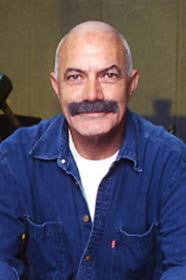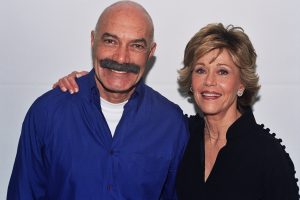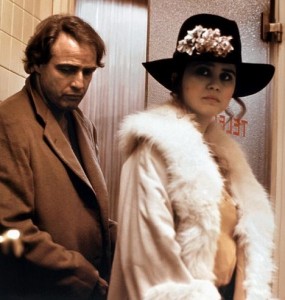 In 1972, the New Yorker’s critic, Pauline Kael, caused a stir when she declared Bernardo Bertolucci’s Last Tango in Paris the most important movie she had ever reviewed–a major “breakthrough” film comparable in its cultural impact to the 1913 premiere of Stravinsky’s Le Sacre du Printemps. In her long review, Kael praised Brando’s amazing skills, specifically his ability to draw directly from life and from himself in constructing his screen characters.
In 1972, the New Yorker’s critic, Pauline Kael, caused a stir when she declared Bernardo Bertolucci’s Last Tango in Paris the most important movie she had ever reviewed–a major “breakthrough” film comparable in its cultural impact to the 1913 premiere of Stravinsky’s Le Sacre du Printemps. In her long review, Kael praised Brando’s amazing skills, specifically his ability to draw directly from life and from himself in constructing his screen characters.
Kael’s praise was, of course, excessive, and Last Tango in Paris is a movie that has not aged particularly well. However, back in 1972, the film, based on original screenplay by Bertolucci and Franco Arcalli, was a shocking spectacle, an event movie–before the term even existed. Among other thing, it demonstrated a feverish eruption by a young, endlessly eager, ideologically-minded filmmaker, who abandoned all safety nets, plunging into a racy exploration of sexuality, seldom seen with such explicit clarity and graphic detail.
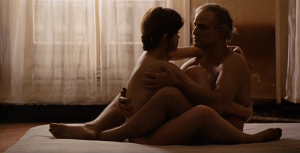 The film tells the story of an expatriate American in Paris, who tries purging himself of bad memories, caused by his wife’s suicide, by entering into a tragic (“no-questions-asked”) sexual liaison with a chance acquaintance, a beautiful girl (Maria Schneider), about to be married.
The film tells the story of an expatriate American in Paris, who tries purging himself of bad memories, caused by his wife’s suicide, by entering into a tragic (“no-questions-asked”) sexual liaison with a chance acquaintance, a beautiful girl (Maria Schneider), about to be married.
The most controversial film of its era (which was x-rated back in 1972) is still explicit by today’s standards, though it’s mellowed somewhat with age. Still, Last Tango in Paris offers a sterling showcase for Bertolucci’s camera mastery and an equally impressive display of Brando’s luminous performance, which was nominated for an Oscar.
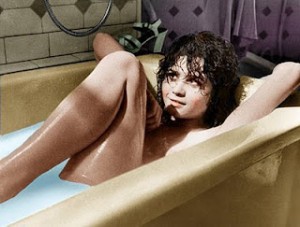 Brando appears as a middle-aged American–decidedly not the type of perky and upbeat American in Paris glorified by George Gershwin and Vincente Minnelli in the 1951 musical, An American in Paris, or Ernest Hemingway. He is confused, tortured, sexually aggressive expatriate, whose wife had just committed suicide. Eager to escape the shabby hotel in which he resides, he finds an apartment in the vicinity of the iconic Eiffel Tower.
Brando appears as a middle-aged American–decidedly not the type of perky and upbeat American in Paris glorified by George Gershwin and Vincente Minnelli in the 1951 musical, An American in Paris, or Ernest Hemingway. He is confused, tortured, sexually aggressive expatriate, whose wife had just committed suicide. Eager to escape the shabby hotel in which he resides, he finds an apartment in the vicinity of the iconic Eiffel Tower.
Accidentally, he meets a young girl named Jeanne (Maria Schneider), who is also looking at the apartment for her and her fiancé after they get married. Jeanne is a modish, temperamental girl, dating Tom (Jean-Pierre Léaud), a young, romantic, immature documentary moviemaker, who follows her about Paris, committing to his camera each and every gesture of hers.
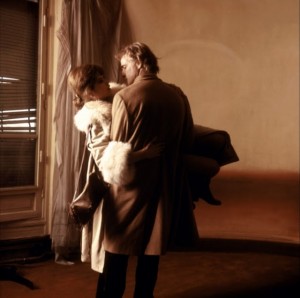 In the large but empty apartment, within minutes after meeting, Paul seduces Jeanne and embarks on a sexual tryst that lasts for three days. The two know nothing of each other, not even their names. Their affair is purely physical, and the apartment becomes a place where they play sexual games, including sado-masochistic ones.
In the large but empty apartment, within minutes after meeting, Paul seduces Jeanne and embarks on a sexual tryst that lasts for three days. The two know nothing of each other, not even their names. Their affair is purely physical, and the apartment becomes a place where they play sexual games, including sado-masochistic ones.
The Famous Butter Scene
They engage in some steamy encounters, the most famous of which involves Schneider face down on the apartment floor while Brando applies butter to her rear and performing anal sex. “That scene wasn’t in the original script. The truth is it was Marlon who came up with the idea,” Schnedier told the UK Daily Mail in a revealing interview in 2007. “They only told me about it before we had to film the scene and I was so angry. I should have called my agent or had my lawyer come to the set because you can’t force someone to do something that isn’t in the script, but at the time, I didn’t know that.
 “Marlon said to me: ‘Maria, don’t worry, it’s just a movie,’ but during the scene, even though what Marlon was doing wasn’t real, I was crying real tears. I felt humiliated and to be honest, I felt a little raped, both by Marlon and by Bertolucci. After the scene, Marlon didn’t console me or apologize. Thankfully, there was just one take.”
“Marlon said to me: ‘Maria, don’t worry, it’s just a movie,’ but during the scene, even though what Marlon was doing wasn’t real, I was crying real tears. I felt humiliated and to be honest, I felt a little raped, both by Marlon and by Bertolucci. After the scene, Marlon didn’t console me or apologize. Thankfully, there was just one take.”
Many believed that the sex scenes between Brando and Schneider were for real, but she insists: “Not at all. There was no attraction between us. For me, he was more like a father figure and I a daughter. “Marlon said to me: ‘You look just like Cheyenne (his daughter, who subsequently committed suicide in 1995) with your baby face.'”
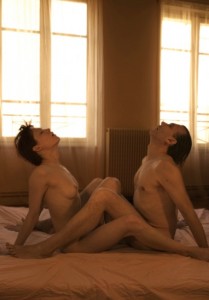 The film is both erotic and intensely realistic in its exploration of sexual values and mores. Bertolucci wrote the screenplay in collaboration with his editor, Franco Arcalli, but in probing the American psyche he relied on Brando’s input. Many directors were driven to distraction by Brando’s notorious methods, his hesitant, questioning approach to his material. But in this case, it was exactly what the director wanted.
The film is both erotic and intensely realistic in its exploration of sexual values and mores. Bertolucci wrote the screenplay in collaboration with his editor, Franco Arcalli, but in probing the American psyche he relied on Brando’s input. Many directors were driven to distraction by Brando’s notorious methods, his hesitant, questioning approach to his material. But in this case, it was exactly what the director wanted.
Last Tango in Paris was shot in Paris for three months, but then went into a long period of editing, due to the great amount of footage, much of it based on improvisation. Bertolucci had prepared a detailed script with all the dialogue, but he was willing to disregard it, whenever Brando wanted to bring his own interpretation. Bertolucci was stimulated by the actor’s constant questioning of lines and motives, and he feels that his association with Brando has furthered his understanding of filmmaking, particularly as it applies to the revealing of human nature.
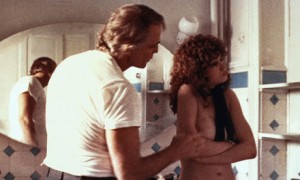 There was hype about the film due to the involvement of Marlon Brando, in the wake of the renewed interest in his career after appearing in Coppola’s The Godfather. The film’s director, Bernardo Bertolucci, then only 32, also added a certain cache. Bertolucci had made five films: The Grim Reaper, Before the Revolution, Partner, The Spider’s Strategy, and The Conformist, for which he was honored by the National Society of Film Critics as best director. But all of his films have played at major film festivals, and he was considered the most brilliant director working in cinema.
There was hype about the film due to the involvement of Marlon Brando, in the wake of the renewed interest in his career after appearing in Coppola’s The Godfather. The film’s director, Bernardo Bertolucci, then only 32, also added a certain cache. Bertolucci had made five films: The Grim Reaper, Before the Revolution, Partner, The Spider’s Strategy, and The Conformist, for which he was honored by the National Society of Film Critics as best director. But all of his films have played at major film festivals, and he was considered the most brilliant director working in cinema.
Last Tango in Paris ran into problems after the first showing to the Italian censors, due to some explicit scenes of sexual intercourse. When it was viewed in New York by United Artists, the execs decided that some editing would be necessary before a general release campaign could be arranged.
 The film was presented as closing night of the New York Film Fest, on October 14, 1972, and it was flown in under guard from Rome with provision for a single showing and then returned the next day. Italian law prohibits the showing of an Italian film abroad before it has passed Italian censors, but an exception was granted. Last Tango in Paris made a stunning impact on the festival’s viewers, creating shock and disturbed responses. Once ruled as not pornographic by Italian courts, it was released theatrically in New York on February 1, 1973.
The film was presented as closing night of the New York Film Fest, on October 14, 1972, and it was flown in under guard from Rome with provision for a single showing and then returned the next day. Italian law prohibits the showing of an Italian film abroad before it has passed Italian censors, but an exception was granted. Last Tango in Paris made a stunning impact on the festival’s viewers, creating shock and disturbed responses. Once ruled as not pornographic by Italian courts, it was released theatrically in New York on February 1, 1973.
Credits
Released by United Artists
Produced by Alberto Grimaldi
Directed by Bernardo Bertolucci
Screenplay by Bernardo Bertolucci and Franci Arcalli
Director of photography, Vittorio Storare; cameraman, Enrico Umetelli
Musical score by Gato Barbieri
Cast:
Paul (Marlon Brando)
Jeanne (Maria Schneider)
Concierge (Darling Legitimus)
Tom (Jean-Pierre Léaud)
TV script girl (Catherine Sola)
TV cameraman (Mauro Marchetti)
TV sound engineer (Dan Diament)
TV assistant cameraman (Peter Schommer)
Catherine (Catherine Allegret)
Monique (Marie-Helene Breillat)
Mouchette (Catherine Breillat)
Rosa’s mother (Maria Michi)
Rosa (Veronica Lazare)
Marcel (Massimo Girotti)
President of tango jury (Mimi Pinson)
Running Time: 129 minutes





